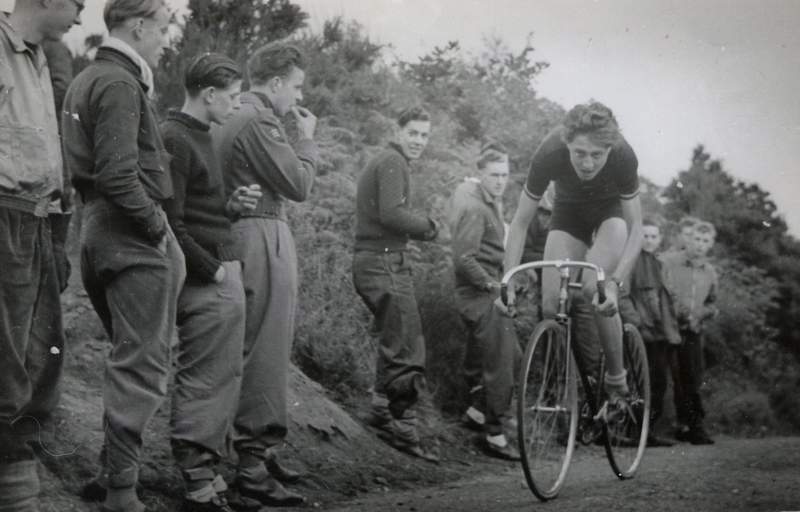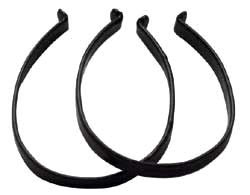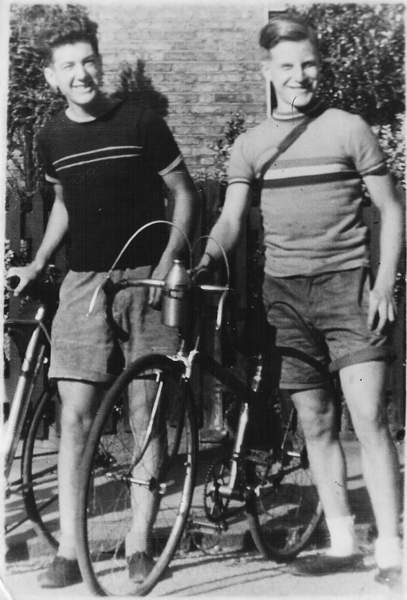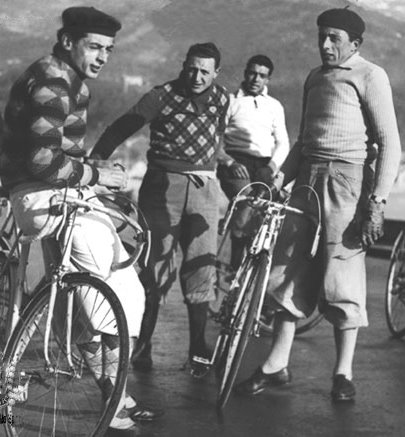Cycling clothes, 1950s style
 Mon, September 27, 2021
Mon, September 27, 2021 
The picture above is from 1952, the year I started racing and riding seriously. The photo taken at a British Hill Climb, typically an end of season event taking place around October when temperatures were falling slightly.
Notice what the spectators are wearing, regular everyday clothes. These cyclists probably rode a considerable distance to the event, the only special equipment is the cycling shoes. Corduroy or heavier tweeds were popular in the colder months, being warm, comfortable, and hard wearing. The thing is these are regular pants or trousers, worn in conjunction with spring steel bicycle clips to keep the bottoms from being caught in the chain.
The thing is these are regular pants or trousers, worn in conjunction with spring steel bicycle clips to keep the bottoms from being caught in the chain.
On the upper body you will notice a mixture of sweaters and light jackets.
In the winter I always wore a woolen undershirt next to my skin, wool stayed warm even when wet from sweat or outside elements. Often when setting out on a ride in the early morning hours, I would place a sheet of newspaper under my top sweater, to keep the cold wind off my chest. Later as the day warmed up, this was discarded.

In the summer cyclists wore regular shorts, and again these were often cut off from a regular pair of street trousers.
The very fact that a person was wearing shorts at all in public, was a sign that they were a serious cyclist. Or someone engaged in some other athletic activity.
Remember this was the 1950s and men usually wore suits and ties. Young boys wore short trousers up until age 13, then most often wore long trousers for the rest of their adult life.
Racing clothes were made out of wool, they were expensive, needed to be hand washed, and took forever to dry. Unlike today, you could not throw them in the drier, or they would become matted and shrink.
No one wore their racing clothes on a training ride. I do remember that when I did put these clothes on to race, they felt so comfortable and unrestrictive that I automatically rode faster.
Racing shorts had a real chamois leather insert inside, and I would smear a handful of Vaseline on it before a race. It felt extremely weird for about the first minute, but then kept me comfortable throughout the race, with zero chaffing.

Even the pros did not wear racing kit for training rides. The picture above is of Fausto Coppi (Left.) with his brother Serse. (Right.) and a few other riders about to set out on a training ride.
The trousers they are wearing would be specially made for cycling, but they are styled after regular street clothes with the exception that they fit just below the knee, and are worn in conjunction with knee length socks. On the top they are wearing a variety of woolen sweaters.
My mother was an expert at sewing, and I would take an old pair of trousers, and have her cut them off just below the knee. She would sew some wide elastic on the bottom to fit under my knee. The material cut from the bottom of the leg, she would make a double seat, which added comfort and made them wear longer.
By the 1970s, proper cycling clothes were available, but there were training clothes and racing clothes. Now it has become acceptable to train or simply ride for pleasure in racing gear. Modern matrials make cycling clothing so easy to wash and care for.
One also has to remember that general fashions change too. I remember some older cyclists would wear a dress shirt and tie to go on a club run. Clothing worn in public now, would have been considered against public decency back in the 1950s and before. Even if one was engaged in an activity like cycling.



















Reader Comments (6)
Love your blog! Greetings from Italy.
Dave,
An indelicate question, but what was worn under the regular shorts or knickers? In other words, what kept everything situated. Was it something like the liners we wear these days under baggy shorts?
I had a pair of wool knickers that I wore when hiking in cold weather.
I also wore them when cycled in the winter in the early 70's.
I had no idea that this was a legitimate thing.
It's so funny these days to see the Freds on expensive battery-shift carbon bikes with their expensive Rapha "limited edition" racing garb, stuck at the side of the road because they have NO idea how their bike works. Maybe they have a delusion that the team mechanic will save them :-)
I used rubber bands to cinch the bottom of my jeans. When I could afford the metal bands, I didn’t like them as well. Rubber bands went all way round, held the fold in your jeans down, and went on/off easier, and disappeared in your pocket when not in use.
I would not have tried rubber bands if I started out using metal bands, why consider using rubber bands after having paid for something designed specifically for pants?
One of the greatest athletes had his shoes stolen at the 1912 Olympics in Stockholm, Sweden, but on the morning of his competitions, he found two different shoes in a garbage can he wore. Jim Thorpe went on to win two gold medals.
Would today’s athlete even consider competing wearing two different size and type of shoes he found in the garbage?
When a cyclist starts on an electric-assist, or E-Bike, is there any reason to try a steel bike, or even a non-motorized carbon bike?
Just what is essential to riding well? You will need history to know where to begin.
I have found that in the summer I can wear light wool trousers rolled up with a rubber band (instant plus-fours!) and knee-high socks. I typically eschew plastic, but modern fishing shirts (button-up) are loose-fitting, dry extremely quickly, and keep me very cool in hot weather. All together, this makes for a very comfortable ride that requires only a modicum of sunscreen on the face. In the shoulder seasons, I switch to wool jerseys and thicker trousers. Modern “base layers” in merino are amazing and I find I don’t even need any kind of chamois (with the correct leather saddle).
I may not look like a speedy MAMIL, but I sure am comfortable!